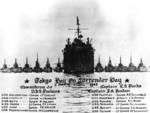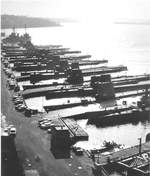Cavalla
| Country | United States |
| Ship Class | Gato-class Submarine |
| Hull Number | SS-244 |
This article has been removed for review and updates, please check back again soon!
Submarine Cavalla (SS-244) Interactive Map
Photographs
 |  |  |
Cavalla Operational Timeline
| 17 Jun 1944 | Shokaku, Zuikaku, Taiho, Ryuho, Haguro, Myoko, Yahagi, Asagumo, Isokaze, Urakaze, Hatsuzuki, Wakazuki, Akizuki, and Shimotsuki departed Philippine waters ad sailed toward Saipan, Mariana Islands at 1530 hours. At 2015 hours, USS Cavalla made radar contact with the Japanese carrier fleet in the Philippine Sea; Commander Herman Kossler decided to sail away in order to surface later, at 2245 hours, to send the contact report to his superiors. Receiving this news, US Navy leadership ordered search planes to be sent to look for this carrier fleet, thus setting up for the subsequent Battle of the Philippine Sea. |
| 19 Jun 1944 | At dawn, flagship Taiho, Shokaku, and Zuikaku launched launched combat air patrol fighters. At 0756 hours, the first major strike force was launched (48 fighters, 53 bombers, and 27 torpedo bombers; led by Lieutenant Commander Akira Tarui). At 0810 hours, USS Albacore hit Taiho with a torpedo in the starboard bow, but Taiho's damage control team allowed the carrier to remain in formation; destroyer Hatsuzuki was left behind to hunt for USS Albacore. At 1020 hours, Zuikaku launched a second strike force (4 fighters and 4 bombers) to join the fourth big raid on on US Navy Task Force 58. Meanwhile, Taiho suspended flight operations due to gas vapor issues and Shokaku was busy with combat air patrol duties through well past 1100 hours. At 1100 hours, Shokaku began recovering 10 fighters; while the recovery process continued, at 1122, Shokaku was hit by three torpedoes from USS Cavalla on the starboard side; two forward near the switchboard and generator room, one aft of amidships. Large fuel fires were ignited in the hangar and No. 1 boiler room went offline. Shokaku remained underway, but began to list to starboard. Counterflooding over-compensated, giving her a port list. Meanwhile flooding and heat of the fires forced shutting down of the boiler rooms. She continued to settle forward. Though damage control initially hoped to save her, the flooding forward and the fires intensify in the following hours. By 1210 hours Shokaku had come to a halt when fires detonate an aerial bomb on the hangar, setting off volatile gases from a cracked forward tank. Large induced explosions wrecked the carrier, and hope began to fade. The list to port and bow trim both increased. Carriers Zuikaku and Taiho were ordered to leave damaged Shokaku behind, while cruiser Yahagi and destroyer Urakaze remained with Shokaku. At 1350 hours, Shokaku strike planes returned, but were ordered away, redirected to Zuikaku and Taiho. By the time Taiho's aircraft returned, the gas vapor leak problem became extremely worrisome, and some of Taiho's aircraft were redirected to Zuikaku. At this time Captain Hiroshi Matsubara of Shokaku had ordered the carrrier abandoned and the crew mustered on the flight deck for flag lowering. However, before the evacuation can proceed far, the bow dipped under and water pours into No. 1 elevator well, causing the carrier to corkscew to port and up-end. Shokaku went down by the bow at 1401 hours, stern raised high. Between 1408 and 1411, four underwater explosions were registered. 58 officers, 830 petty officers and men, 376 members of Air Group 601, and 8 civilians were killed, totalling 1,272 deaths in the sinking of Shokaku. Light cruiser Yahagi and destroyers Urakaze and Hatsuzuki rescued Captain Hiroshi Matsubara among 570 other survivors. At 1432, another disaster struck as the gas vapor aboard Taiho detonated; the explosion engulfed the flagship. Zuikaku was ordered to proceed while Vice Admiral Jisaburo Ozawa to transferred his flag to cruiser Haguro. At the end of the day, the Japanese Navy lost 244 of the 374 aircraft that it had launched during this battle. The US Navy had only lost 20 aircraft. |
Please consider supporting us on Patreon. Even $1 per month will go a long way! Thank you. Please help us spread the word: Stay updated with WW2DB: |
Search WW2DB

More on Cavalla
Partner Sites Content:» Cavalla Submarine Operations Research Group Attack Data
Current Site Statistics
- » 1,173 biographies
- » 337 events
- » 44,917 timeline entries
- » 1,245 ships
- » 350 aircraft models
- » 207 vehicle models
- » 376 weapon models
- » 123 historical documents
- » 261 facilities
- » 470 book reviews
- » 28,507 photos
- » 365 maps
Famous WW2 Quote
"The raising of that flag on Suribachi means a Marine Corps for the next 500 years."James Forrestal, Secretary of the Navy, 23 Feb 1945
Support Us
Please consider supporting us on Patreon. Even $1 a month will go a long way. Thank you!
Or, please support us by purchasing some WW2DB merchandise at TeeSpring, Thank you!